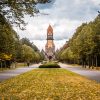Overview
Cities and researchers in China and EU are experimenting with UF-NBS at different urban scales, from the regional, peri-urban to the street level. These efforts create a living laboratory for new ideas on how to plan, establish, govern, manage and monitor tree-rich landscapes for the benefit of urban societies at large.
At the same time, there is an urgent need to systematically review, connect and expand the existing fragmented knowledge and experience on the potential of UF-NBS. This need is the starting point for CLEARING HOUSE: bringing together two major arenas of urban development, Europe and China, the motivation is to learn across local experiences and to improve the development of what is collectively termed the “urban forest” at a larger scale.
CASE STUDY
This case study looks into Kraków River Parks, which create the blue-green network of the city, including rivers and streams with their valleys. Kraków and its metropolitan area faces uncontrolled urban sprawl and housing development, resulting in areas of green spaces being shrunk and the air and rivers being considerably polluted. As the main challenge relates to governance planning and policy landscape, the case study focuses on the development of business models for the implementation of UF-NBS.
Description
Please wait while flipbook is loading. For more related info, FAQs and issues please refer to DearFlip WordPress Flipbook Plugin Help documentation.
Comparative Analysis
City pairings and specific UF-NBS challenges
Specific questions identified as critical will be addressed by the CLEARING HOUSE research team in a comparative setting. The city pairings and specific UF-NBS challenges will be further solidified in view of enabling the most insightful comparative analysis in response to the co-design process.
MORE ON KRAKOW
Business model for implementing UF-NBS for air-quality improvement.
Historical city and industrial district of Nowa Huta, significant share of natural areas, high pollution.



